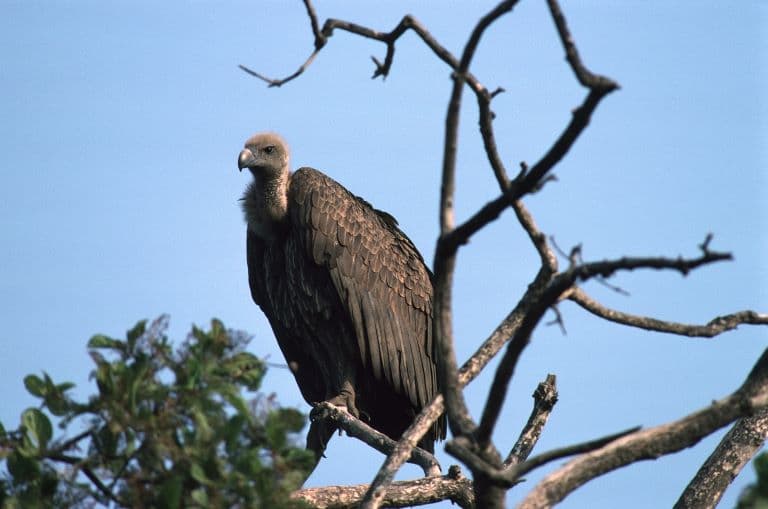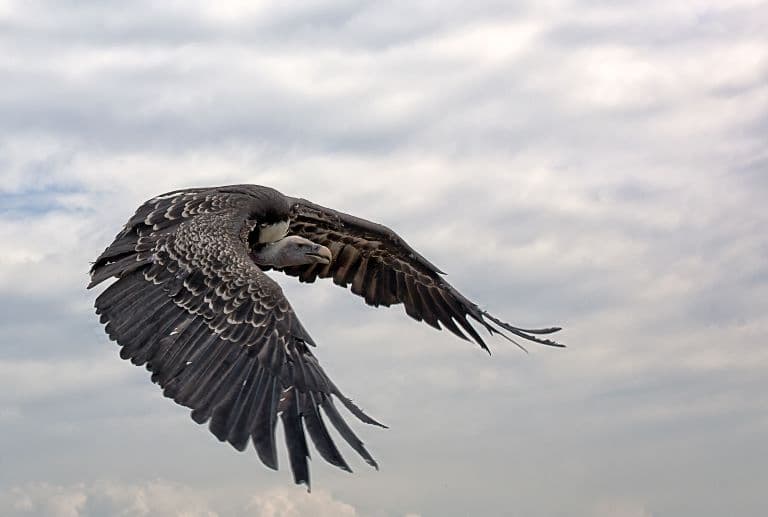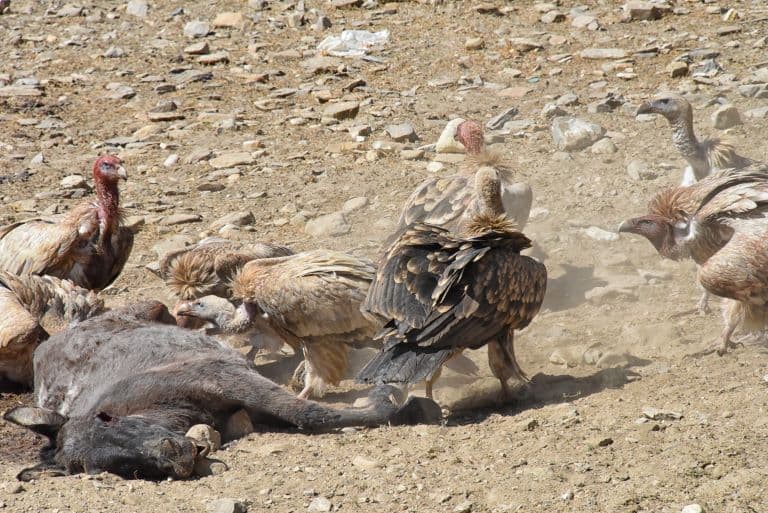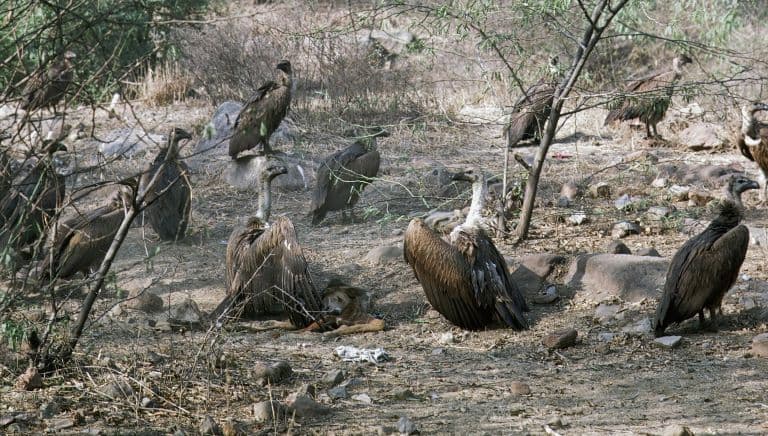White-Rumped Vulture Profile
There are some serious lookers in the vulture community. While some, like the King and bearded vultures, get points for being very pretty, others should be recognised for being particularly vulture-looking.
And among these, the white-rumped vulture should get a genuine mention.
While the conscientious wider society has thankfully moved on from distinguishing birds by their butts, ornithologists have yet to catch on, and the white-rumped vulture deserves to be recognised for so much more than a dazzling behind.

White-Rumped Vulture Facts Overview
| Habitat: | Forest, savanna, grassland, shrubland |
| Location: | Primarily India, Myannmar, Cambodia, Nepal, Pakistan |
| Lifespan: | 17 years |
| Size: | 85 cm (33.46 in) tall, up to 210cm (82.68 in) wingspan. |
| Weight: | Up to 7.5kg (16.52 lb) |
| Colour: | Dark, grey-black with white ruff, back and underwings. |
| Diet: | Carrion |
| Predators: | Eggs are taken by reptiles, humans, feral dogs are a threat to adults |
| Top Speed: | Up to 90 mph |
| No. of Species: | 1 |
| Conservation Status: | Critically Endangered (IUCN) |
The white-rumped vulture is at the smaller end of the griffon vultures, but as vultures go, it really looks the part. A powerful, hooked beak sits between two piercing eyes on a velvety, bald head.
These striking birds are classic scavengers, feeding on carrion that they can find by smell alone. They ride the morning thermals to high altitudes but can fly surprisingly fast when it has to.
Once one of the most populous raptors, it’s now in extreme decline and critically endangered, but there is a glimmer of home in some populations that show signs of recovery.
Interesting White-Rumped Vulture Facts
1. They’re griffon vultures
The white-rumped vulture is very closely tied to the Eurasian griffon vulture and shares the genus. This makes it one of eight Gyps vultures, and the only of its kind – there are no subspecies of Gyps bengalensis.
This genus is the most common in both Africa and India, including 90% of vultures in Africa and closer to 99% in India. And this species in particular was once one of the most dominant in the world.
2. They’re fast!
You wouldn’t know from looking at them perched on the ground, their bald necks tucked between hunched shoulders, but this is a very agile animal.
These birds are built for soaring. Their ability to ride thermals lets them circle at altitudes as great as 2,700m (9000ft), and cruise up there are speeds of around 80 km/h (50 mph).
But when they really want to move, it’s said that these birds can hit speed peaks of up to 120 km/h! They’re also known to cover more than 300km a day in pursuit of food, and they do most of this with exceptional efficiency, making use of both thermal updrafts and gravity to traverse impressive heights and distances without using too much energy.
And from all the way up there, they can still find food on the ground. 1 2

3. They have an excellent sense of smell
That old wisdom about not touching a fledgling for fear of it being rejected by its parents is a bit of a myth. Most birds don’t have a very developed sense of smell, and likely wouldn’t notice the greasy pizza residue of a well-wishing human on their chick, let alone be averse to it.
There are some exceptions, though. Kiwis are known to sniff out earthworms, and seabirds like the shearwater pick up on fish oil and squid juice from quite a distance. Vultures are also endowed with a keen sense of smell and can notice dead flesh on the wind from quite a distance.
4. They’ll eat almost anything
Anything that was once an animal, that is. They’re not too fussy about where their carrion comes from and will visit anything from a dead elephant to a rotting fish carcass to feed. These are the epitome of generalist scavengers, and this makes them significant contributors to the hygiene of their ecosystems.
Unfortunately, this diverse diet is one of the key reasons for the recent decline in the species.

5. They were once one of the most abundant birds of prey in the world
Until recently, this was a very common bird. Once spanning much of Asia, it was formally described as possibly the most abundant large raptor in the world. There would have once been several millions of individuals scanning their territories and cleaning up corpses.
But during the ‘90s, something changed.
6. Then, they declined immensely
Across the range of this species, white-rumped vulture numbers tanked. This happened both within and outside of protected areas to the same degree, and from all those millions, fewer than 9,000 are thought to remain.
This alarming freefall in numbers happened so quickly. Birds were seen looking sickly, with drooping necks, and dead animals, both young and old were showing up all over their range. But food availability remained stable, so these weren’t starving, something else was causing their rapid decline. 3
7. They get kidney failure
In Southeast Asia, the collapse of wild ungulate populations led to the almost total disappearance of this species. Replacing wild land with livestock grazing removed much of the food supply for these vultures, but this wasn’t enough to explain the extent of their decline elsewhere.
As it turned out, these poor birds were disappearing as a result of kidney failure. And the culprit wasn’t a disease, it was, ironically, a medicine used to treat livestock.
Diclofenac, used widely across the globe to treat farm animals, is deathly toxic to vultures. And since vultures like this feed on anything meaty, they are particularly vulnerable to exposure.
Conservationists showed through modelling that these birds are so sensitive to Diclofenac poisoning that only one in 760 livestock carcasses needed to contain Diclofenac residues for the vulture species to decline as much as they have. And when livestock were sampled, the rate was close to 10%.
Public education is slow to address this issue, and a lot of people still don’t make the link, or if they do, understand why it’s a problem.
But, some efforts to address this issue are showing promise. 4
8. There has been a partial recovery in Nepal
Where the use of Diclofenac by vets was banned in Nepal, vulture-save zones were also set up, in which awareness was the primary focus of vulture conservation.
Vulture-safe food was also provided, and an alternative to diclofenac, meloxicam, was promoted. Analysis of the population showed an initial decline between 2002 and 2013, and then an uptick in numbers from 2013 to 2018.
This was mirrored in another species of vulture, the Slender-billed Vulture, whose decline apparently ceased around 2012.
Importantly, the rate of increase here exceeds that of the predicted increase you’d see in a closed system, where vultures were just left with perfect conditions to multiply by themselves, which suggests that others were coming into the environment from elsewhere.
So, it looks like the enforcement of bans on diclofenac use in livestock – something which really took effect around 2011 – has shown tremendous success, not only in protecting local vulture populations but also in creating a safe space for visiting populations who make use of the vulture-friendly food supply. 5

White-Rumped Vulture Fact-File Summary
Scientific Classification
| Kingdom: | Animalia |
| Phylum: | Chordata |
| Class: | Aves |
| Order: | Accipitriformes |
| Family: | Accipitridae |
| Genus: | Gyps |
| Species: | Bengalensis |
Fact Sources & References
- “Gyps bengalensis Indian white-backed vulture”, Animal Diversity Web.
- “White-rumped Vulture”, Publication.
- V. Prakash (2003), “Catastrophic collapse of Indian white-backed Gyps bengalensis and long-billed Gyps indicus vulture populations”, Save Vultures.org.
- “White-rumped Vulture”, IUCN Red List.
- TOBY H. GALLIGAN (2019), “Partial recovery of Critically Endangered Gyps vulture populations in Nepal”, Cambidge University Press.
